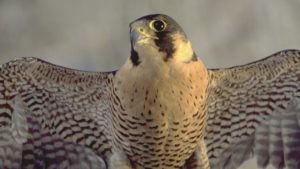On 8 June Mary Hennen came to ring the chicks, and was able to identify them as three females and a male. As in the UK, ringing studies have provided invaluable information about the life history of city-dwelling peregrines in North America. Mary told us that the adults tend to be year-round residents of the city – six pairs can now be found within 13km2. By contrast, the juveniles can make some epic journeys. For example, a female hatched in Chicago has been spotted in New York, while one of the city’s young males has been found in Ecuador. Ringing ha s also highlighted illegal persecution, which – again like in the UK – is very much an issue. The month before we arrived in Chicago, a female peregrine known as ‘Soare’ was shot by persons unknown.
s also highlighted illegal persecution, which – again like in the UK – is very much an issue. The month before we arrived in Chicago, a female peregrine known as ‘Soare’ was shot by persons unknown.
FLEDGE FOR FREEDOM
It was exciting to speculate where Dacey’s high-rise brood might next be spotted, but before that they had to fledge successfully. It seemed that the chicks had enjoyed their taste of freedom while being ringed, because two days afterwards a couple of the females escaped the confines of the ever-more-crowded window box, moving to the floor of the balcony. The biggest fear was that these chicks would fledge prematurely and end up stuck or hurt.
Not all peregrine eyries in Chicago are on skyscrapers -one is much lower, on Evanston Public Library just north of the city centre. A pair have nested here for 10 years. “Nona and Squawker are beloved by residents of all ages,” says Karen Danczak Lyons, the library’s director. “Some Evanston residents even arrange their annual holiday around the fledging time.” The Evanston Library Fledge Watch runs shifts so that if recently fledged juveniles land somewhere unsafe the volunteers can return them to their ledge.
Back at Dacey’s apartment, we watched as the youngest chick moved unsteadily from the window box to the balcony floor. It was a huge relief when the youngster made it. All four chicks used their new-found space to strengthen their wings with bouts of flapping, preparing for the next big step. The moment finally arrived on 2 July as we gathered round Dacey’s computer, glued to the live feed from his peregrine webcam. The chicks were about to make their maiden flights. Within just two days, all four juveniles were throwing themselves into the job of learning how to be supreme aerial hunters, encouraged by their parents. The juveniles’ aerobatic chases and games of tag were thrilling yet deadly serious drills. Life is tough for young peregrines: roughly half of them don’t survive their first year.

However, if you’re a peregrine then Chicago is a good place to be. “If you look at the city’s buildings as pseudo cliffs, situated on an ample waterway, then if s an ideal habitat,” Mary explains. Research suggests that the breeding success of peregrines in the USA’s urban Mid-West (calculated as the average number of fledglings per nest) is among the highest anywhere in North America. Dacey’s pair of peregrines are part of a much bigger success story for the raptor in Chicago. The peregrine disappeared from the region completely in the years after World War II due to DDT poisoning – in fact by the 1960s none at all were left in the eastern USA. But the species was reintroduced in 1985, and has recovered brilliantly. “Peregrines are such a high-profile species – people get excited about them,” says Mary. “So our programme is able to draw on a big volunteer base – all of the people who live and work in buildings where the birds nest, and who love to follow their progress. The story of peregrines in Chicago is a fantastic springboard for environmental education and awareness.”















